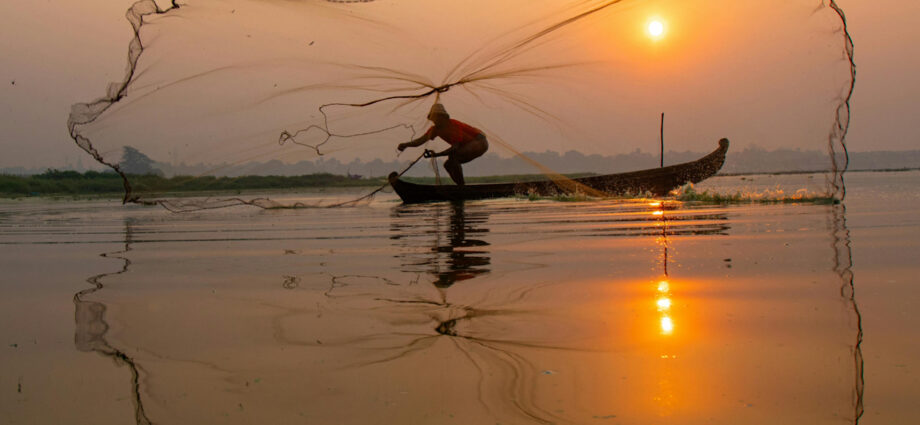
Rashid Sumaila, University of British Columbia
November 11, 2025
The world’s oceans are vital for life on Earth. Drifting phytoplankton provide almost half the oxygen released into the atmosphere. Marine and coastal ecosystems provide food and protect communities from storms.
Nearly 30 per cent of the world’s population lives in coastal areas. However, rapidly changing climate and massive biodiversity losses represent an unprecedented threat to these ecosystems and to life on Earth as we know it. Research shows that coastal regions bear the brunt of climate change and extractive impacts.
Industrial fishing can extract in a day what a small boat might take in a year. Since 1950, carbon dioxide emissions from global marine fisheries have quadrupled. Bottom trawling — where a ship tows a large net along the seafloor — adds further damage by disturbing carbon-rich seafloor sediments.
Scientists estimate that between 1996 and 2020, 9.2 billion tons of carbon dioxide were released into the atmosphere due to bottom trawling — about 370 million tons annually, double the emissions from fuel combustion of the entire global fishing fleet of four million vessels.
By the middle of this century, 12 per cent of nearshore ocean areas could be transformed beyond recognition. In the tropics — Earth’s life ring — human-driven impacts are expected to triple by 2041-60. Our planet’s oceans are facing a critical risk, and we must act urgently to protect them in ways that also benefit the people who rely on them.
As COP30 gets underway in Belem, Brazil, developing measures to protect the world’s oceans and fisheries must be on the agenda.
The key lies in empowering those who have long stewarded these ecosystems: Indigenous and coastal communities. Their traditional fishing practices, passed down through generations, offer a model for balancing ecological recovery with human well-being. Governments must listen to and learn from them.
The industrial threat
To include climate-regulating habitats in global conservation goals, governments must develop policy solutions that prioritize small-scale fishers and Indigenous and coastal communities and mitigate the destructive impacts of industrial fishing fleets.
One in every 12 people globally — nearly half of them women — depend at least partly on small-scale fishing for their livelihood. In contrast to destructive industrial fleets, small-scale fisheries are among the most energy-efficient, animal-sourced food production systems, with low environmental impacts in terms of greenhouse gas and other stressors and outsized economic and social value.
An important measure that could both support small-scale fisheries and contribute to countries’ contributions under global frameworks such as the United Nations Sustainable Development Goals is the formal exclusion of destructive industrial fishing from nearshore waters.
Inshore exclusion zones (IEZs) — also called preferential access areas — are coastal areas that prohibit certain methods of industrial fishing and grant preferential access to small-scale fishers.
When paired with co-management between governments and communities, IEZs can help restore fish populations and strengthen food security and livelihoods.
A promising example is in Ghana, where a bill has just been signed by the president to extend IEZs from six to 12 nautical miles, protecting more coastal waters for small-scale fishers.
An inclusive solution
To support these essential producers while meeting climate and biodiversity goals, governments must apply existing policies in ways that centre people.
The UN’s Global Biodiversity Framework, adopted in 2022, recognizes Indigenous Peoples and local communities as custodians of biodiversity. It also commits governments to protect at least 30 per cent of land and sea by 2030.
But governments must avoid the trap of “paper protection” — designating areas as protected without real enforcement or community involvement. Instead, we need practical, inclusive approaches that uphold both conservation and equity.
Locally led protection
I’m an adviser to Blue Ventures, a non-governmental organization working with coastal communities to restore their seas and build lasting prosperity. The organization helped pioneer the Locally Managed Marine Area (LMMA) model, which blends traditional knowledge and spiritual belief with modern conservation science.
LMMAs protect coral, mangrove and seagrass habitats, increase participation in biodiversity stewardship, enhance food security and build climate resilience.

Supporting coastal communities to establish functional and legal LMMAs — while excluding carbon-intensive industrial fishing from these areas — and recognizing and embedding the approach into global biodiversity frameworks and targets would mark an important shift in valuing conservation outcomes in areas where humans and marine life coexist.
If inclusive marine protection methods, like LMMAs and similar areas under traditional governance, were recognized as key tools to protect biodiversity, we could see a welcome alliance of formally protected areas and those under local governance, all contributing to global conservation targets.
Ultimately, governments should aim to protect more than just 30 per cent of the ocean. To do so, they must pursue equitable, inclusive solutions that align with global goals. We need a future where community-led management of nearshore waters supports both people and nature. We owe it to each other, and to the ocean that gives us life.
Rashid Sumaila, Director & Professor, Fisheries Economics Research Unit, University of British Columbia
Subscribe to our newsletter.
This article is republished from The Conversation under a Creative Commons license. Read the original article.

